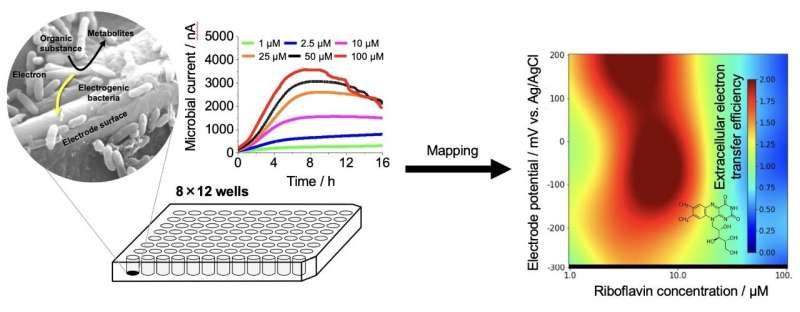New electrochemical measurement output uses data science to reveal microbial electricity generation mechanisms
05/01/2023
A developed high-throughput electrochemical device enables simultaneous independent electrochemical measurements in the 96-well electrochemical plate with three electrodes printed at the bottom of every well. High-throughput comparison and analysis of different electrochemical conditions among the wells. Results of the evaluation of power generation enhancement efficiency against riboflavin concentrations and electrode potentials in Shewanella spp. using a Gaussian process regression model, showing high performance over a wide range of electrode potentials in the low-concentration region. Credit: Akihiro Okamoto / National Institute for Materials Science
Researchers at Japan's National Institute for Materials Science (NIMS) have developed a device capable of taking hundreds of times more electrochemical measurements than conventional devices. By analyzing the device's large amounts of data, the team has identified molecular mechanisms that enable electrogenic bacteria to efficiently generate electricity even when subjected to a wide range of electrode potentials.
This technique can also be used to analyze materials interacting with microorganisms (e.g., biodegradable plastics), potentially facilitating efforts to discover innovative microbial degradable materials.
The work was published in the journal Patterns in October, 2022.
Some microorganisms can generate electricity while purifying waste water. Because this eco-friendly power generation mechanism is influenced by various factors, conventional experimental and theoretical approaches to understanding and controlling it have been difficult. Data science—the analysis of massive amounts of data—had been considered a potentially effective approach to this problem. However, it requires large amounts of high-quality electrochemical data with defined conditions and little variability, which has made it virtually impossible to accomplish technically and economically.
The researchers developed an electrochemical measurement system capable of taking hundreds of times more 3-electrode electrochemical measurements than conventional systems. They then constructed a high-quality database, and analyzed the data using data science techniques to determine the relationship between bacterial electricity generation efficiency and the concentration of external factors enhancing bacterial extracellular electron transfer.
In addition, they identified the mechanisms by which riboflavin molecules serve as extracellular electron transporters, enabling electrogenic bacteria to efficiently generate electricity even when subjected to a wide range of electrode potentials.
The team's newly-developed electrochemical measurement system is considerably more cost-efficient than conventional systems and has exhibited high measurement reproducibility. This is the first research to demonstrate that data science techniques (i.e., analyzing huge amounts of electrochemical measurement data) can be used effectively in microbial electrochemistry research.
Moreover, because the electric current produced by microorganisms is an indicator of their metabolic activity levels, this system can be used to measure the impact of microorganisms on biomaterials. For example, the rate at which biodegradable plastics disintegrate should be positively correlated with the amount of electric current produced by the microorganisms decomposing them.
The system can also be used to measure the electric current produced by the microorganisms associated with various materials. This data could then be analyzed using data science techniques to predict materials with superior physical properties, potentially expediting efforts to discover new, effective materials.
This project was led by Miran Waheed (JSPS Postdoctoral Research Fellow (at the time of this research), Electrochemical Nanobiotechnology Group (ENG), International Center for Materials Nanoarchitectonics (MANA), NIMS); Gaku Imamura (Senior Researcher, ENG, MANA, NIMS) and Akihiro Okamoto (Leader of ENG, MANA, NIMS).
Source: https://bit.ly/3W4XqZS, via Phys.Org

